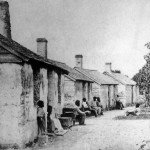Search results
November 2011: Discovery Kingsley Plantation Slave Cemetery
November 13, 2011 by ramona
Filed under Articles, Cemetery Searches, Genealogy Cemetery Searches, Genealogy Records 101
 The rare discovery of a 19th century slave cemetery was made in the summer of 2010 by University of Florida anthropologist James Davidson. The site containing the skeletal remains of six individuals was found on the Kingsley Plantation, Fort George Island, Jacksonville Florida; home to the Timucuan Ecological and Historic Preserve. Working with the University of Florida’s archeological field school, Davidson, who led the expedition says,
The rare discovery of a 19th century slave cemetery was made in the summer of 2010 by University of Florida anthropologist James Davidson. The site containing the skeletal remains of six individuals was found on the Kingsley Plantation, Fort George Island, Jacksonville Florida; home to the Timucuan Ecological and Historic Preserve. Working with the University of Florida’s archeological field school, Davidson, who led the expedition says,
“We didn’t stumble over this by accident like so many of these discoveries, we had reason to believe this was here for a long time.”
The clues that led to discovery
Study of the Kingsley plantation began as early as 1968 by former University of Florida professor Dr. Charles Fairbanks, who conducted an excavation of a slave cabin on the site. Continuing this work, Davidson, following century old leads that depicted the site as being in close proximity to an old oak tree, found the site located slightly off the main road leading to the plantation house. Nearby were the remains of the old slave quarters. Several clues including square cut nails and a number of buttons helped establish a date for the burials. Osteological measurements (measurements of bones) indicated that the remains were of African descent, validating the authenticity of the site.
The remains
Of the remains discovered, there were three children, a woman of approximately 60 years old, a man of approximately 40 years old and a sixth body whose age and gender could not be determined. Out of respect for the dead all artifacts will remain at the site and will not be removed to another location.
Why this is important
Often buried without ceremony, with no grave markers left to characterize the lives of slaves or denote their passing. Archeological finds of this magnitude may give slaves and their descendants some resolution, in addition to well deserved acknowledgement. Although announcements of the discovery were suspended to permit further research and allow for the possibility of finding descendants; in this instance there is no way to identify the remains. No documentation has been found that could lead to the identification of living relatives.
Conclusion
Dr. Johnetta Cole, a descendant of the Kingsley family and director of the Smithsonian Institution’s National Museum of African Art, speaking in a press conference about the discovery states,
“My ancestral roots are so deeply planted in this place, you can’t know where you’re going if you don’t know where you’ve been. This discovery of an African burial ground, a burial ground of enslaved people, helps us to understand where all of us have been and now where and how we can go forward.”
